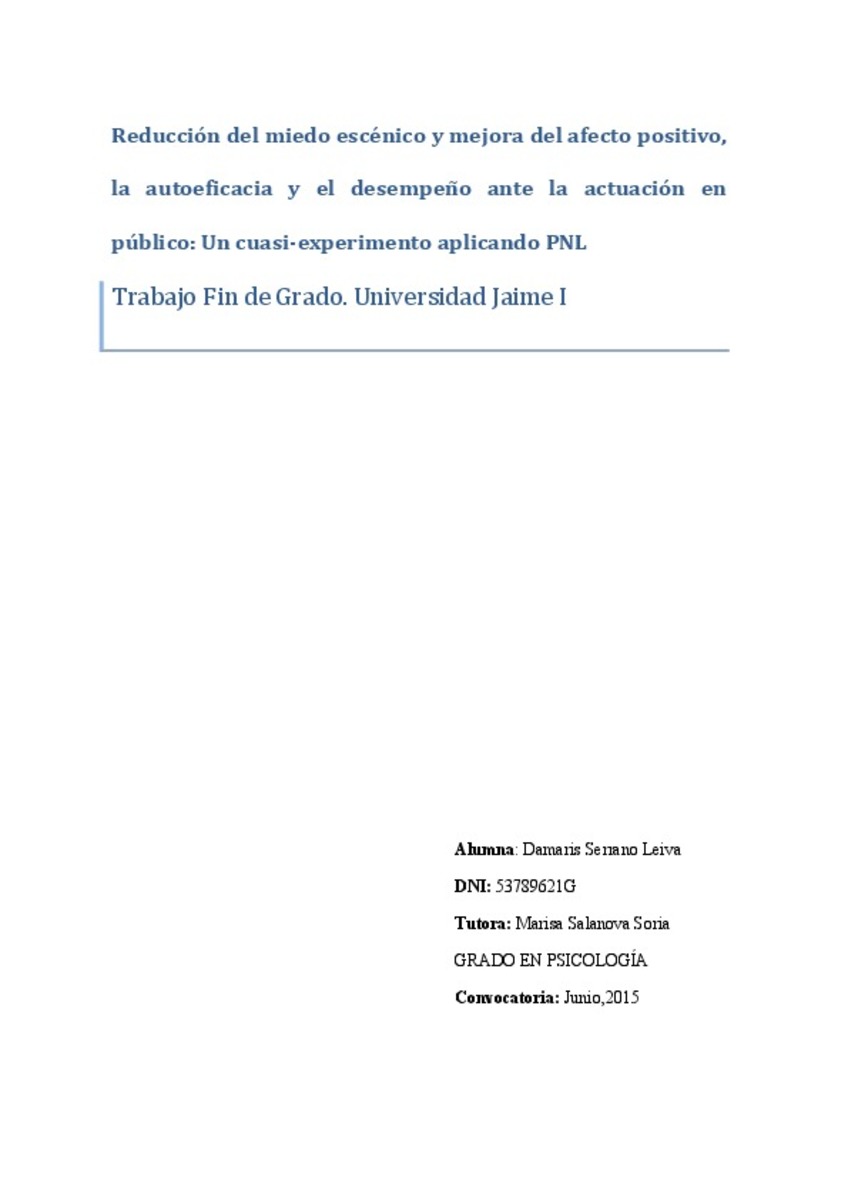Mostrar el registro sencillo del ítem
Reducción del miedo escénico y mejora del afecto positivo, la autoeficacia y el desempeño ante la actuación en público: un cuasi=experimento aplicando PNL
| dc.contributor | Salanova Soria, Marisa | |
| dc.contributor.author | Serrano Leiva, Damaris | |
| dc.contributor.other | Universitat Jaume I. Departament de Psicologia Evolutiva, Educativa, Social i Metodologia | |
| dc.date.accessioned | 2015-07-29T08:40:07Z | |
| dc.date.available | 2015-07-29T08:40:07Z | |
| dc.date.issued | 2015-05-15 | |
| dc.identifier.uri | http://hdl.handle.net/10234/129485 | |
| dc.description | Treball final de Grau en Psicologia. Codi: PS1048. Curs acadèmic 2014-2015 | ca_CA |
| dc.description.abstract | En este estudio, se llevó a cabo un cuasi-experimento con el fin de evaluar la eficacia de dos técnicas en Programación Neuro Linguística (PNL): anclas y submodalidades en la mejora del afecto positivo, autoeficacia y desempeño, y la reducción del miedo escénico y del afecto negativo en alumnos de teatro de la Escuela Municipal de Villarreal. Para ello, se establecieron dos condiciones: Un grupo experimental y un grupo de espera. Un total de 22 sujetos participaron voluntariamente en el experimento y fueron asignados a la condición experimental o de espera dependiendo de sus niveles de Ansiedad Rasgo (STAI) y del curso al que pertenecían (1º o 2º). Los resultados indican que la intervención con anclas y submodalidades tiene efectos principalmente en la mejora de la autoeficacia y del desempeño | ca_CA |
| dc.description.abstract | The purpose of this study is to show, throught an quasi-experiment, the effectiveness of two Neuro-Linguistic Programming (NLP) techniques: anchoring and submodalities in improving positive affect, self-efficacy and performance, and in reducing stage fright and negative affect in theater students of the public Theater School of Villarreal. For that, two conditions were established: an experimental group and a waiting group. A total of 22 subjects participated voluntarily in the experiment and they were assigned to the experimental condition or waiting group depending on their levels of Trait Anxiety (STAI) and of course they belonged (1st or2nd). The results indicate that interventions with anchoring and submodalities have effects principally in improving self-efficacy and performance. | ca_CA |
| dc.format.extent | 43 p. | ca_CA |
| dc.format.mimetype | application/pdf | ca_CA |
| dc.language.iso | spa | ca_CA |
| dc.publisher | Universitat Jaume I | ca_CA |
| dc.rights | Attribution-NonCommercial-ShareAlike 4.0 Spain | * |
| dc.rights.uri | http://creativecommons.org/licenses/by-nc-sa/4.0/ | * |
| dc.subject | Grau en Psicologia | ca_CA |
| dc.subject | Grado en Psicología | ca_CA |
| dc.subject | Bachelor's Degree in Psychology | ca_CA |
| dc.subject | PNL | ca_CA |
| dc.subject | Anclajes | ca_CA |
| dc.subject | Submodalidades | ca_CA |
| dc.subject | Autoeficacia | ca_CA |
| dc.subject | Afecto negativo | ca_CA |
| dc.subject | Afecto positivo | ca_CA |
| dc.subject | Desempeño | ca_CA |
| dc.subject | Miedo escénico | ca_CA |
| dc.subject | Teatro | ca_CA |
| dc.subject | NLP | ca_CA |
| dc.subject | Anchoring | ca_CA |
| dc.subject | Submodalities | ca_CA |
| dc.subject | Self-efficacy | ca_CA |
| dc.subject | Negative affect | ca_CA |
| dc.subject | Positive affect | ca_CA |
| dc.subject | Performance | ca_CA |
| dc.subject | Stage fright | ca_CA |
| dc.subject | Theater | ca_CA |
| dc.title | Reducción del miedo escénico y mejora del afecto positivo, la autoeficacia y el desempeño ante la actuación en público: un cuasi=experimento aplicando PNL | ca_CA |
| dc.type | info:eu-repo/semantics/bachelorThesis | ca_CA |
| dc.educationLevel | Estudios de Grado | ca_CA |
| dc.rights.accessRights | info:eu-repo/semantics/openAccess | ca_CA |
Ficheros en el ítem
Este ítem aparece en la(s) siguiente(s) colección(ones)
-
Grau en Psicologia [1080]
PS1048








